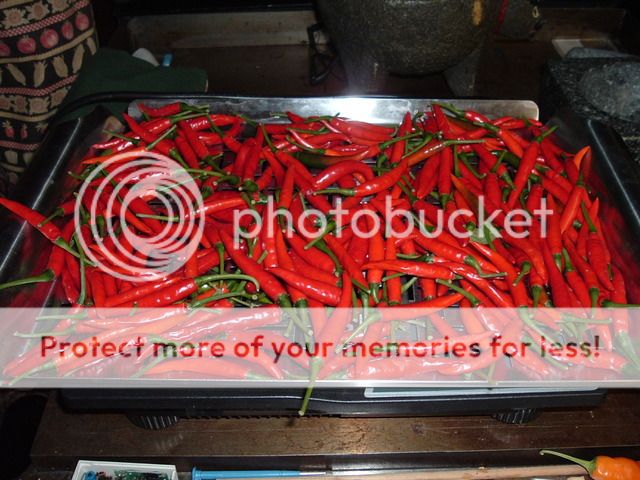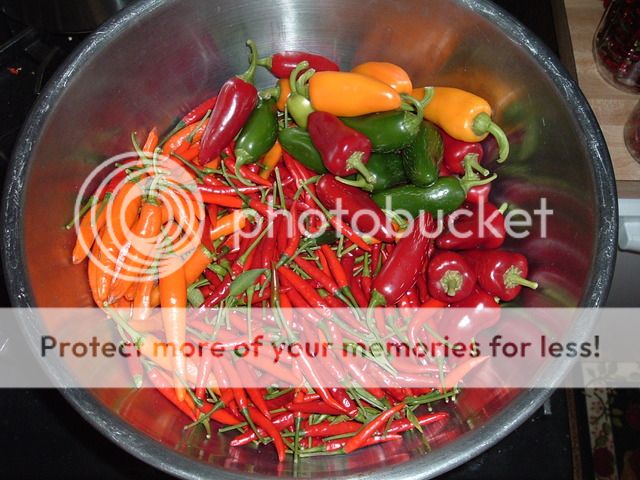Hi,
My potted birdseye chilli has had progressively chlorotic lower leaves for the last couple months. It seemed most likely to be from magnesium deficiency according to research, so I watered it a few times with epsom salts. However, the leaves still look like those in the photo even after a couple weeks. Plenty of full-sized fruits on the plant, but none are ripening. Additionally, some new upper leaves are thin with wrinkled edges. I've been fertilizing once monthly with Jobe's organic tomato and vegetable fertilizer. What should I do next?
-
Beige thumb
- Newly Registered
- Posts: 1
- Joined: Wed Sep 02, 2015 8:51 am
- rainbowgardener
- Super Green Thumb
- Posts: 25279
- Joined: Sun Feb 15, 2009 6:04 pm
- Location: TN/GA 7b
Hi and welcome to the Forum! To start with you need to tell us where you are and what your temps/ weather has been like lately. There are hardly any garden questions that can be discussed without regard to location/ climate/ weather etc.
Not for sure if I would even call those leaves chlorotic, which usually more definitely preserves the green along the veins:

https://www.clantontree.com/images/iron- ... s-leaf.png
But doesn't matter, they are definitely yellowing.
In the first picture, the pot looks very small for the size of the plant. You are trying to make up for lack of soil with added ferts -- almost in the direction of hydroponics, which uses no soil and all added ferts (which they call nutes, for nutrients). Your Jobe's is good stuff, but it is 2-7-4. That is good ratio for what you want, but 1/ mo with low concentration fert may not be enough to compensate for so little soil. What was the soil you started with and did it have built in nutrients?
What we might suggest you do next depends on where you are located and how much growing season you have left. Are you somewhere where your pepper can over-winter outdoors? If not, were you planning to bring it in for the winter (assuming you are in the No. hemisphere and are approaching fall)? Or just start over next year? Peppers are actually tender perennials, which many of us northerners treat as annuals.
With more information, hopefully we can help you more.... Best Wishes!
Not for sure if I would even call those leaves chlorotic, which usually more definitely preserves the green along the veins:

https://www.clantontree.com/images/iron- ... s-leaf.png
But doesn't matter, they are definitely yellowing.
In the first picture, the pot looks very small for the size of the plant. You are trying to make up for lack of soil with added ferts -- almost in the direction of hydroponics, which uses no soil and all added ferts (which they call nutes, for nutrients). Your Jobe's is good stuff, but it is 2-7-4. That is good ratio for what you want, but 1/ mo with low concentration fert may not be enough to compensate for so little soil. What was the soil you started with and did it have built in nutrients?
What we might suggest you do next depends on where you are located and how much growing season you have left. Are you somewhere where your pepper can over-winter outdoors? If not, were you planning to bring it in for the winter (assuming you are in the No. hemisphere and are approaching fall)? Or just start over next year? Peppers are actually tender perennials, which many of us northerners treat as annuals.
With more information, hopefully we can help you more.... Best Wishes!
-
pepperhead212
- Super Green Thumb
- Posts: 2878
- Joined: Wed Oct 15, 2014 1:52 pm
- Location: Woodbury NJ Zone 7a/7b
Welcome to the forum, Beige!
Funny you should mention this, because I have the same thing happen often, and mostly on Thai peppers, but not on Thai Birds. I have a theory about it (just that - a theory), and that is that the plants have too many peppers to support, as it always seems to be the ones that have the most peppers.
I always let about 2/3 of my Thai peppers from the first crop (they seem to be what I call a determinate pepper) turn red, and harvest all of them, leaving the greens. Very quickly they create another flush of blossoms, with a large number of peppers added onto the remaining peppers from the first batch. This is when it seems the most productive ones get some yellowing of the leaves. Just today I harvested my second crop from all of my Thai peppers, and one variety of which I have two plants had one plant with a huge number of red peppers on it, and many very yellow leaves (with green veins, as in chlorosis), while the plant next to it had all green leaves, yet only about half as many peppers on it. Maybe the plants are in survival mode, creating as many seeds as possible, thus channeling the energy to the peppers, rather than the leaves. And maybe the shorter days trigger this; even though peppers are not really a deciduous plant, the more seeds produced for the next season, the better the rate of survival of the species.
Here are some of the Thai peppers from a new variety - Thai Red Vesuvius - which has also shown some tendency to yellowing. But you can see the incredible production - all of the first two from 3 plants!
8-12 - first harvest:

8-23 - second harvest:

9-2 third harvest - not all the Thai peppers (about 5 qts of them) under the rest are from the 3 plants, but most of them are:

Funny you should mention this, because I have the same thing happen often, and mostly on Thai peppers, but not on Thai Birds. I have a theory about it (just that - a theory), and that is that the plants have too many peppers to support, as it always seems to be the ones that have the most peppers.
I always let about 2/3 of my Thai peppers from the first crop (they seem to be what I call a determinate pepper) turn red, and harvest all of them, leaving the greens. Very quickly they create another flush of blossoms, with a large number of peppers added onto the remaining peppers from the first batch. This is when it seems the most productive ones get some yellowing of the leaves. Just today I harvested my second crop from all of my Thai peppers, and one variety of which I have two plants had one plant with a huge number of red peppers on it, and many very yellow leaves (with green veins, as in chlorosis), while the plant next to it had all green leaves, yet only about half as many peppers on it. Maybe the plants are in survival mode, creating as many seeds as possible, thus channeling the energy to the peppers, rather than the leaves. And maybe the shorter days trigger this; even though peppers are not really a deciduous plant, the more seeds produced for the next season, the better the rate of survival of the species.
Here are some of the Thai peppers from a new variety - Thai Red Vesuvius - which has also shown some tendency to yellowing. But you can see the incredible production - all of the first two from 3 plants!
8-12 - first harvest:

8-23 - second harvest:

9-2 third harvest - not all the Thai peppers (about 5 qts of them) under the rest are from the 3 plants, but most of them are:

I don't think the leaves are chlorotic. They look more mottled but not like pepper mottle virus. I would repot the plant in a five gallon container in potting soil. Peppers are heavy feeders especially when they are loaded. Your "bird peppers" look like tabasco or superchili. They have a pepper load of about 200 when they are fully mature. A two foot plant should not have no more than about 30.
Repot and I give my peppers a slow release fertilizer (osmocote type 100= good for about 3 months). I also side dress with about a tablespoon of citrus food once a month.
If the problem is a nutrient deficiency the repotting, regular fertilizer, and picking off the peppers to reduce the load.
It is unusual for it to be a pest problem because pests usually go for the youngest leaves first. Nitrogen, Potassium are some of the deficiencies that start from the lower leaves, but the pattern is different. It could be a trace element or pH. Usually repotting and fertilizing usually fixes nutritional problems up quickly.
Repot and I give my peppers a slow release fertilizer (osmocote type 100= good for about 3 months). I also side dress with about a tablespoon of citrus food once a month.
If the problem is a nutrient deficiency the repotting, regular fertilizer, and picking off the peppers to reduce the load.
It is unusual for it to be a pest problem because pests usually go for the youngest leaves first. Nitrogen, Potassium are some of the deficiencies that start from the lower leaves, but the pattern is different. It could be a trace element or pH. Usually repotting and fertilizing usually fixes nutritional problems up quickly.
